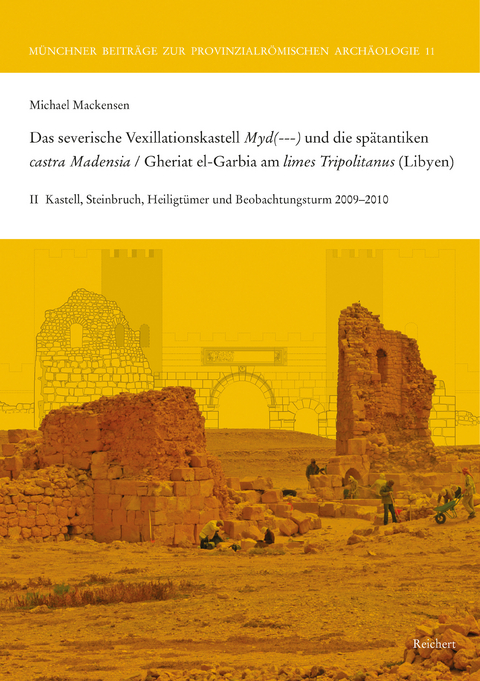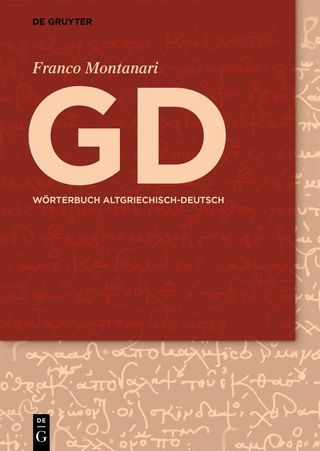Das severische Vexillationskastell Myd(---) und die spätantiken castra Madensia / Gheriat el-Garbia am limes Tripolitanus (Libyen)
II Ausgrabungen und Untersuchungen im Kastell, im Steinbruch, in den Heiligtümern und am Beobachtungsturm 2009-2010
Seiten
Das Kastell Myd(---) ist das größte der von legionaren Arbeitsvexillationen aus Lambaesis (Ostalgerien) unter Kaiser Septimius Severus im Jahr 201 fertig gestellten neuen Kastelle an der weit nach Süden vorgeschobenen Grenze Tripolitaniens. Es liegt am Übergang von der Halb- zur Steinwüste oberhalb einer großen Oase. Die Ausgrabungen konzentrierten sich auf die vier, teilweise bis 10 m hoch erhaltenen Tore des Kastells und das Stabsgebäude. Nach Aufgabe des Kastells um 275/280 ist eine neuerliche Nutzung nach Instandsetzungsarbeiten im späten 4. und der ersten Hälfte des 5. Jahrhunderts von großer Bedeutung. Das Kastell ist mit den in der Notitia Dignitatum Occ. 31, 30 genannten castra Madensia identifizierbar.
The Roman fort of Gheriat el-Garbia is located 280 km south of Tripoli in the pre-desert, above an oasis, on the central route into the Fezzan. Along with Bu Ngem and Ghadames, it is the largest of the new vexillation forts of the limes Tripolitanus that were advanced far to the south under emperor Septimius Severus. At the latest by autumn AD 201 its defences were finished by a detachment (vexillatio) of Legio III Augusta from Lambaesis (Algeria). The task of the garrison was to control and secure the transport routes as well as to monitor the (semi-)nomadic autochthonous tribes. Within the framework of an interdisciplinary project of the Archaeology of the Roman Provinces at the University of Munich, funded by the DFG Excellence Initiative, four campaigns were carried out in 2009 and 2010. The focus was laid on surveys and excavations within the fort, which was overbuilt by a Berber village, in the quarries and in one of the sanctuaries. In addition to scientific investigation methods (geodesy, geophysics, archaeometry, radiocarbon analyses), terrestrial 3D laser scanning was used. The first volume with the research history of the Tripolitanian frontier zone, the archaeological survey with architectural elements, inscriptions and much pottery was published in 2021. This second volume presents the investigation of the defences of the 2.25 ha fort used from 199/201 to 275/280, whose ancient place-name Myd(---) is recorded in an inscription. The new reconstruction of the Severan porta praetoria with the towers preserved up to 10 m high is of significance far beyond the region. In addition, there is documentation of the remaining three gates, two intermediate towers (up to 8 m high) and the northern corner tower as well as the excavation of the headquarters building. The fortifications of the Severan vexillation forts – from Castellum Dimmidi to Gholaia/Bu Ngem – are analyzed comparatively and the layout of Myd(---)/Gheriat el-Garbia with its interior buildings is reconstructed. An unexpected discovery was a late Antique reoccupation of the fort, which had not been used by Rome for about a century. A military unit of limitanei, the milites munifices, was garrisoned there from 380/390 until the middle of the 5th century. The fort can be identified with the castra Madensia mentioned in the Notitia Dignitatum occ. XXXI 30. Coins and radiocarbon dates have been crucial for dating the repairs of the fortifications and the remodelled headquarters building. Investigations of closed deposits with small finds, pottery and ostraca as well as macrobotanical and archaeozoological remains provide important insights into the provisioning, diet and living habits of a late Antique garrison on the Tripolitanian limes.
The Roman fort of Gheriat el-Garbia is located 280 km south of Tripoli in the pre-desert, above an oasis, on the central route into the Fezzan. Along with Bu Ngem and Ghadames, it is the largest of the new vexillation forts of the limes Tripolitanus that were advanced far to the south under emperor Septimius Severus. At the latest by autumn AD 201 its defences were finished by a detachment (vexillatio) of Legio III Augusta from Lambaesis (Algeria). The task of the garrison was to control and secure the transport routes as well as to monitor the (semi-)nomadic autochthonous tribes. Within the framework of an interdisciplinary project of the Archaeology of the Roman Provinces at the University of Munich, funded by the DFG Excellence Initiative, four campaigns were carried out in 2009 and 2010. The focus was laid on surveys and excavations within the fort, which was overbuilt by a Berber village, in the quarries and in one of the sanctuaries. In addition to scientific investigation methods (geodesy, geophysics, archaeometry, radiocarbon analyses), terrestrial 3D laser scanning was used. The first volume with the research history of the Tripolitanian frontier zone, the archaeological survey with architectural elements, inscriptions and much pottery was published in 2021. This second volume presents the investigation of the defences of the 2.25 ha fort used from 199/201 to 275/280, whose ancient place-name Myd(---) is recorded in an inscription. The new reconstruction of the Severan porta praetoria with the towers preserved up to 10 m high is of significance far beyond the region. In addition, there is documentation of the remaining three gates, two intermediate towers (up to 8 m high) and the northern corner tower as well as the excavation of the headquarters building. The fortifications of the Severan vexillation forts – from Castellum Dimmidi to Gholaia/Bu Ngem – are analyzed comparatively and the layout of Myd(---)/Gheriat el-Garbia with its interior buildings is reconstructed. An unexpected discovery was a late Antique reoccupation of the fort, which had not been used by Rome for about a century. A military unit of limitanei, the milites munifices, was garrisoned there from 380/390 until the middle of the 5th century. The fort can be identified with the castra Madensia mentioned in the Notitia Dignitatum occ. XXXI 30. Coins and radiocarbon dates have been crucial for dating the repairs of the fortifications and the remodelled headquarters building. Investigations of closed deposits with small finds, pottery and ostraca as well as macrobotanical and archaeozoological remains provide important insights into the provisioning, diet and living habits of a late Antique garrison on the Tripolitanian limes.
| Erscheinungsdatum | 25.09.2024 |
|---|---|
| Reihe/Serie | Münchner Beiträge zur Provinzialrömischen Archäologie ; 11 |
| Zusatzinfo | 34 Tafeln |
| Verlagsort | Wiesbaden |
| Sprache | deutsch |
| Maße | 210 x 297 mm |
| Themenwelt | Kunst / Musik / Theater |
| Sachbuch/Ratgeber ► Freizeit / Hobby ► Kreatives Gestalten | |
| Geisteswissenschaften ► Archäologie | |
| Geschichte ► Allgemeine Geschichte ► Altertum / Antike | |
| Schlagworte | Altertumswissenschaften • Archäologie • Ausgrabung • Heiligtum • Kunst |
| ISBN-10 | 3-7520-0691-9 / 3752006919 |
| ISBN-13 | 978-3-7520-0691-9 / 9783752006919 |
| Zustand | Neuware |
| Haben Sie eine Frage zum Produkt? |
Mehr entdecken
aus dem Bereich
aus dem Bereich
Die unglaubliche Geschichte eines antiken Söldnerheeres
Buch | Hardcover (2022)
C.H.Beck (Verlag)
28,00 €
die Inszenierung der Politik in der römischen Republik
Buch | Hardcover (2023)
C.H.Beck (Verlag)
48,00 €




